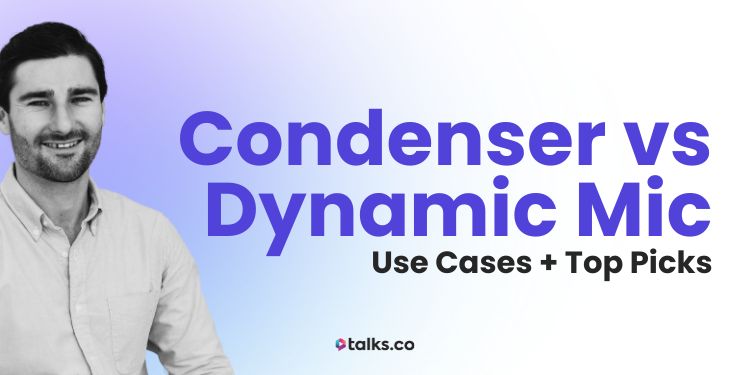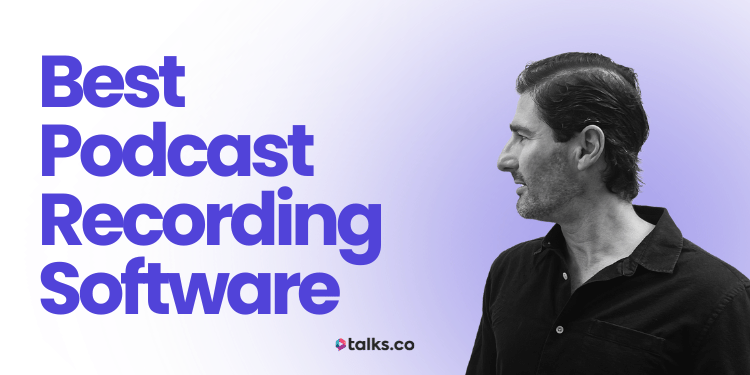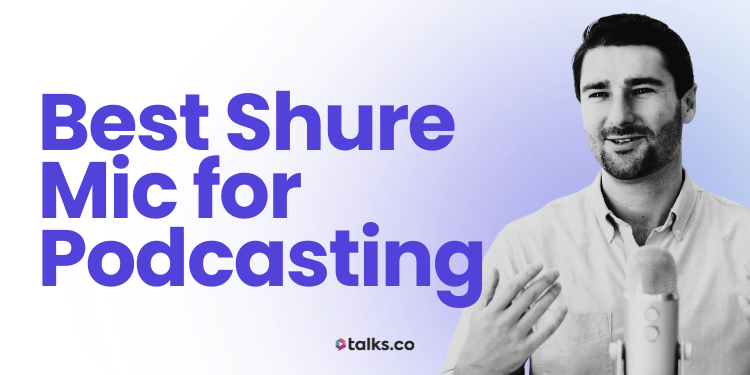You’ve got something to say. Now you need a mic that actually makes you sound good.
Search “podcast mic” and suddenly it’s condenser this, dynamic that. Specs. Buzzwords. Confusion.
The condenser vs dynamic mic debate comes up fast. And if you don’t know the difference, it’s easy to pick the wrong one for how you record.
But it’s not that complicated. You just need to know what each mic does, when to use them, and what actually fits how you record.
I’ve tested gear in spare rooms, echoey kitchens, on the road, and in home studios from Sweden to Sydney. I know what works and what’s not worth your time.
This guide breaks it down with real examples and the kind of tips I wish I had when I started.
Let’s get you sorted with the right microphone.
What Is a Condenser or Dynamic Microphone?

Choosing a mic for podcasting usually comes down to two types: condenser or dynamic. You don’t need to be super into tech to figure it out.
Here’s the short answer:
- Condenser mics pick up everything. Crisp vocals, tiny room sounds, even your chair creaking. Great if your setup is quiet and treated.
- Dynamic mics are more focused. They zero in on your voice and ignore most background noise. Perfect for home setups or echoey spaces.
If your room isn’t soundproofed, or if you’ve got background noise (like a fan or the occasional dog bark), a dynamic mic is your safest bet.
But if your space is treated and you want maximum vocal detail, a condenser mic might give you that extra polish.
Function of condenser or dynamic microphone
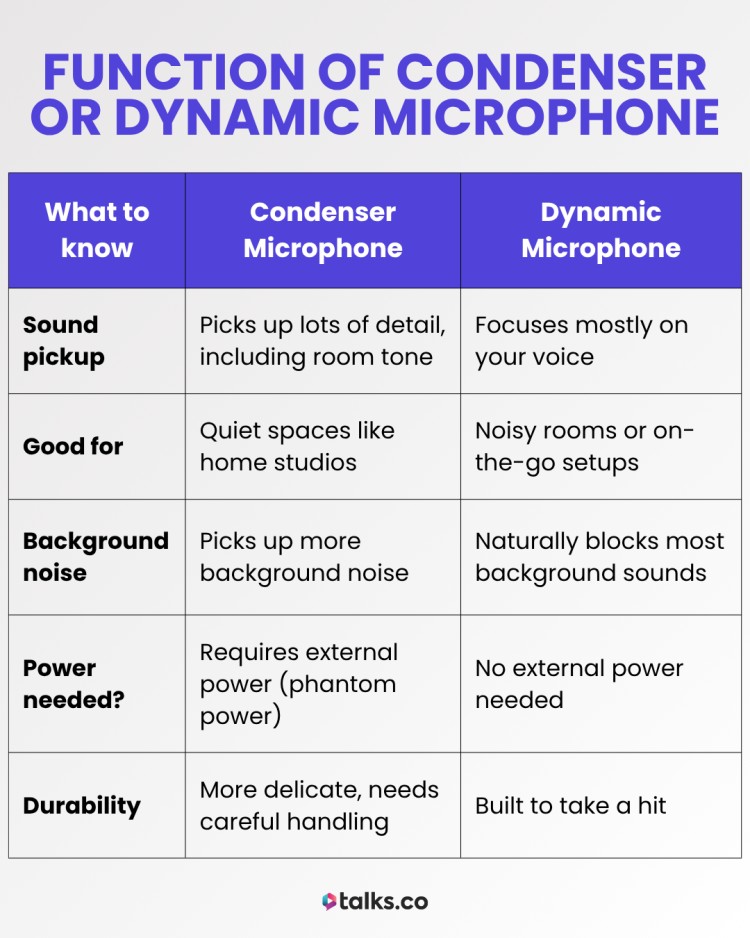
Here’s a quick comparison of how condenser and dynamic microphones work and how they affect your sound.
| What to know | Condenser Microphone | Dynamic Microphone |
| Sound pickup | Picks up lots of detail, including room tone | Focuses mostly on your voice |
| Good for | Quiet spaces like home studios | Noisy rooms or on-the-go setups |
| Background noise | Picks up more background noise | Naturally blocks most background sounds |
| Power needed? | Requires external power (phantom power) | No external power needed |
| Durability | More delicate, needs careful handling | Built to take a hit |
Dynamic vs Condenser vs Ribbon Mic
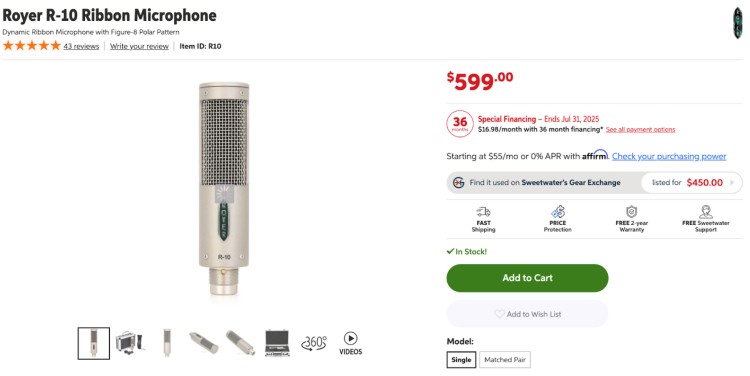
These three mic types work very differently, and your recording setup will feel that difference. Here are three specific mics so you can see how they compare in action.
| Microphone | Type | Best for | Why it’s used |
| Shure SM7B | Dynamic | Untreated rooms Podcasting | Reduces background noise Handles loud voices |
| Audio-Technica AT2020 | Condenser | Treated rooms Voicecovers Livestreams | Picks up crisp high-end detail Great for vocals |
| Royer R-10 | Ribbon | Warm vocals Vintage sound | Warm, smooth sound Delicate and pricey |
Quick note on ribbon mics: These are specialty tools. Smooth, vintage sound, but fragile and expensive. Unless you’re chasing an old-school radio vibe or already deep into audio gear, you can skip them.
Which Is Better: Condenser or Dynamic Mic?
It depends on your setup, but comparing real mics side by side helps you decide.
Here’s how a popular dynamic microphone and a condenser microphone can deliver for different types of podcasts and their recording environment.
| Feature | Rode NT1 5th Gen (Condenser) | Electro-Voice RE20 (Dynamic) |
| Sound pickup | Very sensitive | Focused and clean |
| Best in | Treated studio rooms | Home setups with noise |
| Needs power? | Yes, phantom power | No |
| Price | $250 | $450 |
Bottom line:
- Go for a condenser if your space is quiet and you want every vocal detail.
- Go for a dynamic if your room is echoey, noisy, or has no acoustic treatment. Dynamic microphones are less sensitive types of microphones.
Not sure what all the tech terms mean? Here’s a quick cheat sheet so you don’t have to Google it mid-scroll.
- Phantom power: Extra power sent through your audio cable so condenser mics can work. Most audio interfaces handle this automatically.
- XLR: A 3-pin cable used with professional studio-level mics. Gives better sound than USB and works with mixers/interfaces.
- Pickup pattern: The shape of the area a mic “listens” to. Polar pattern is the technical term for this. Cardioid mics (the most common for podcasts) focus on sound right in front of them.
- Plosives: Harsh “P” and “B” sounds that hit the mic too hard. A pop filter can help.
- Gain: How much your mic boosts the signal before recording. Too low = quiet. Too high = distorted.
- Preamp: A device (or part of your mixer/interface) that boosts your mic’s signal so it can be heard clearly.
Are condenser mics better than dynamic?
Depends on your setup and what kind of sound you want.
How condenser mics work:
- Use a thin diaphragm and charged backplate to convert sound waves into an electrical signal.
- Need phantom power and a quiet, treated recording environment.
- Capture crisp, detailed audio with high sensitivity and a wide frequency response.
- Great for solo podcasters, voiceovers, and studio use.
- More sensitive to background noise like fans, echoes, or city sounds due to their open polar pattern and ability to pick up subtle vibrations.
How dynamic mics work:
- Use a coil and magnet that generates current as the diaphragm vibrates with incoming sound waves.
- Don’t need phantom power and can handle rougher recording environments.
- Lower sensitivity, but excellent at rejecting unwanted noise. Typically have a tighter polar pattern, which helps isolate the voice.
- Ideal for untreated rooms or on-the-go setups.
- Popular with live performers, mobile podcasters, and anyone dealing with background noise.
So, are condenser mics better than dynamic?
They can be, but only if your space is quiet and your gear can power them. Otherwise, a well-chosen dynamic mic will give you a cleaner sound when you record your podcast.
When to Use Dynamic vs Condenser Mic (Checklist)
Still not sure which one to grab? Here’s a quick checklist to help match your mic to your space and situation.
Use a condenser mic if:
☐ Your room is treated: You’ve added soundproofing like foam panels or heavy curtains to reduce echo.
☐ You record solo content: Voiceovers, livestreams, or podcasts where detail and clarity matter most.
☐ You speak softly: You want to capture quieter tones without needing to push your voice.
☐ Your space is quiet: A dedicated home office or studio with minimal background noise.
☐ You want studio-like Zoom calls: Clean, polished audio for professional virtual meetings.
Use a dynamic mic if:
☐ Your room has no soundproofing: You record in shared spaces or rooms with natural echo and reverb.
☐ You deal with background noise: Kids, pets, traffic, or household sounds that can’t be controlled.
☐ You move while talking: You shift or lean in/out during recording and need consistent volume.
☐ You want a hassle-free setup: Plug in and record without extra gear like phantom power.
☐ You want to block distractions: Focus on your voice while reducing surrounding noise naturally.
Condenser vs dynamic mic for home recording
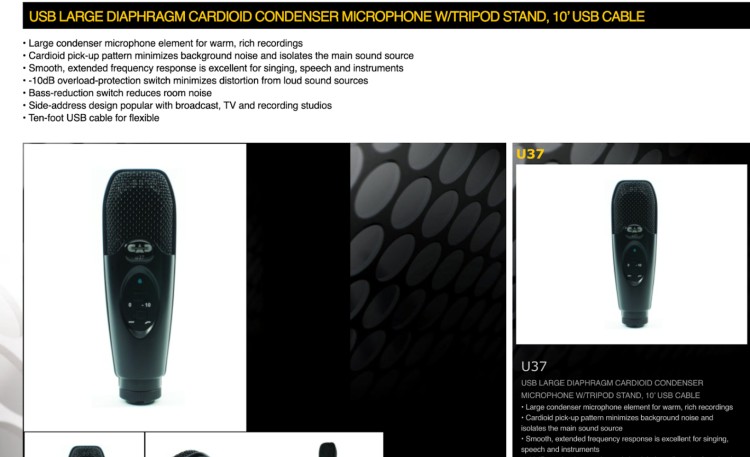
Recording at home sounds great until you notice your space pushing back. Maybe your bedroom has a bit of echo or your living room picks up the fridge hum and passing traffic.
If you:
- Record in a shared or basic podcast room setup
- Get background noise like street sounds, appliances, or creaky floors
- Want a mic that works well even if your space isn’t perfect
These are the mics I’d recommend:
Dynamic mic: Audio-Technica ATR2100x-USB
- Price: $79
- Connection: USB and XLR
- Pros: Good noise rejection, headphone monitoring, versatile connection
- Cons: Basic build, not studio-grade detail
Condenser mic: CAD U37
- Price: $50
- Connection: USB
- Pros: Warm sound, easy plug-and-play, affordable
- Cons: Picks up more room noise, needs quiet space
Condenser vs dynamic mic for Zoom
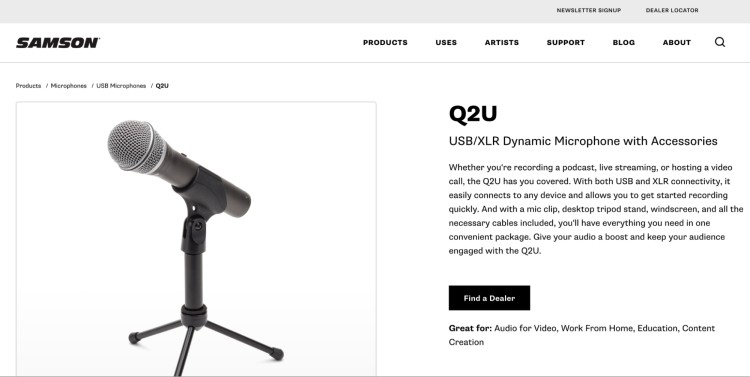
Zoom calls can get messy if your home office isn’t quiet. Maybe your keyboard clicks or there’s background chatter.
If you:
- Join calls from your desk, kitchen table, or shared spaces
- Have noises like typing, pets, or conversations nearby
- Want a mic that makes you sound clear and professional
These are the mics I’d give as gifts to podcasters who want to sound clear on Zoom:
Dynamic mic: Samson Q2U
- Price: $70
- Connection: USB and XLR
- Pros: Cuts background noise, headphone monitoring, flexible connections
- Cons: Basic stand, less refined than higher-end mics
Condenser mic: Blue Yeti Nano
- Price: $80
- Connection: USB
- Pros: Compact, multiple pickup patterns, easy and cheap podcast setup
- Cons: Picks up more ambient noise, no XLR option
Condenser or dynamic mic for home studio
Ready to upgrade from your podcast starter kit to a better choice and build a solid home studio setup?
If you:
- Have a treated or quiet spot at home
- Still get some city or outside noise in your recordings
- Want gear that delivers rich, clear sound for podcasting or voice work
Here are the mics I’d pick for this kind of setup:
Dynamic mic: Electro-Voice RE320
- Price: $299
- Connection: XLR
- Pros: Clear, natural voice tone, excellent noise rejection, versatile for spoken word and instruments
- Cons: Needs audio interface, a bit bulkier
Condenser mic: AKG C214
- Price: $399
- Connection: XLR
- Pros: Crisp and detailed sound, handles loud sources well, rugged metal build
- Cons: Requires phantom power, picks up more room noise
Condenser vs Dynamic Mic for Podcasting
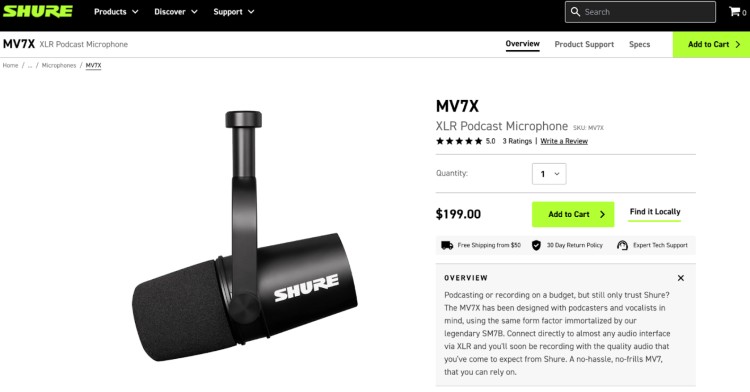
Picking the right microphone is a critical step when it comes to how you want your podcast to sound and where you’re recording.
If you:
- Want your voice to come through clear and strong
- Need something that cuts out background noise or handles a treated room
- Are serious about stepping up your gear
These are the mics I’d pick for anyone serious about improving their sound:
Dynamic mic: Shure MV7X
- Price: $179
- Connection: XLR
- Pros: Podcast-ready sound, solid background noise rejection, smaller and lighter than SM7B
- Cons: XLR only, needs audio interface to work
Condenser mic: Warm Audio WA-14
- Price: $399
- Connection: XLR
- Pros: Big, clear sound with solid presence, built tough for serious recording
- Cons: Needs a quiet space and phantom power
Which microphone should you choose for your podcast?
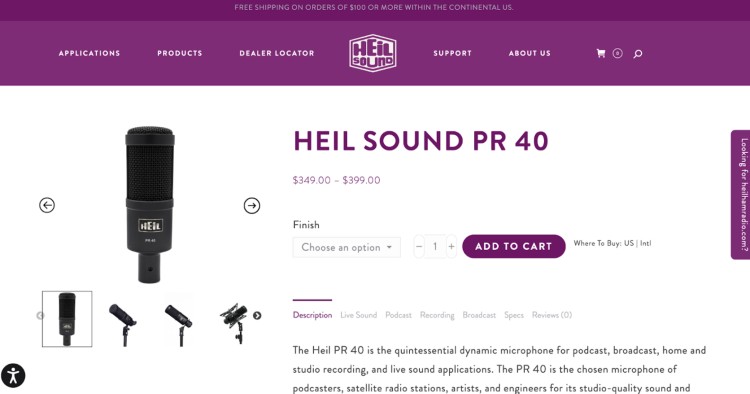
Choosing the right mic boils down to your space and how much control you have over sound.
Simple hack: Loud room? Go dynamic. Quiet room? Go condenser.
Still unsure? I’ve tested dozens of mics and podcast equipment bundles and narrowed down the list to five clear winners each. All easy to use, great sound, and actually worth the money.
These are the mics I’d pick:
Top 5 dynamic mics (best if you can’t control background noise):
- Heil PR-40: Focused pickup that cuts out street sounds and keyboard clicks. Best for creators in noisy environments who want that broadcast-quality voice.
- MXL BCD-1: Keeps your voice clear and tight, even if your room echoes or bounces sound around. Ideal if you’re working in a basic room and still want to sound clean.
- Tascam TM-82: Gives clean voice recordings with minimal setup. A good pick for beginners who want an easy plug-and-play setup.
- Behringer XM8500: Tough mic that sounds good even when you’re moving or handling it roughly. Perfect for podcasters on the road or recording in shared spaces.
- AKG D5: Built for live shows, so it blocks out distractions and keeps your voice front and center. Great if you record interviews or panels in less controlled setups.
Top 5 condenser mics (best if you’ve treated your room or it’s naturally quiet):
- Lewitt LCT 240 PRO: Picks up every subtle detail, giving your voice depth and clarity. Great for solo podcasters and narrators in quiet, treated spaces.
- Behringer C-1: Straightforward, clean sound. Great for basic home setups that are already quiet. Nice entry-level option if you’re just starting your podcast on a budget and want clear sound without overkill.
- AKG P220: Adds warmth and texture, making your voice feel full and natural. Ideal for interviews or storytelling formats where tone matters.
- Samson C01: Crisp and clear, perfect for smaller rooms where every detail counts. Reliable for creators with light treatment who want rich vocals.
- Elgato Wave:3: USB mic that captures clear audio and has built-in level controls. Perfect if you want clean sound and simple software control in one package.
Quick maintenance tips most podcasters skip
Even a great mic sounds off if you don’t treat it right. These quick tips keep your dynamic and condenser microphones clean, clear, and ready every time you record.
- Keep condenser mics away from moisture. Steam, spills, even humid air can mess with the internals of a dynamic or condenser mic.
- Use a pop filter or windscreen. It protects the mic and gives your sound a studio-quality touch.
- Wipe down your mic regularly. Buildup can muffle audio over time.
- Store your mic carefully. Dynamic mics are tougher, but still benefit from a little care.
- Check your cable connections often. A crackling mic is usually a loose plug.
You Sound Good. Now Book Great Guests.
Choosing between a condenser vs dynamic mic isn’t just about sound quality. It’s about how you show up to your listeners.
The right mic makes your voice clear and confident, but what really sets your podcast apart is the guests you bring on who keep your audience engaged and coming back.
Ready to boost your podcast with the right voices?
Set up your Talks creator profile free today and connect with guests who’ll make your show impossible to ignore.
Lock In Your Next Podcast Guests Now
